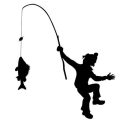1. Introduction: The Summer Fishing Dilemma
For anglers across the United States, summer brings with it a unique challenge: deciding whether to cast your line at dawn or wait until dusk. This decision isn’t just about personal preference—it can make or break your fishing trip. Early mornings and late evenings both offer distinct advantages, but local conditions such as water temperature, weather patterns, and regional fish behavior play a significant role in determining which time is optimal. Understanding how these factors interact is essential for any fisherman hoping to maximize their catch during the hot summer months. In this article, we’ll dive into why choosing between early morning and late evening fishing is so critical, and how tuning into your local environment can help you make the best call for a successful day on the water.
2. Early Morning Fishing: Perks and Pitfalls
For many American anglers, there’s nothing quite like heading out to the water at first light. Early morning fishing, especially during the summer, offers a unique set of advantages and some notable challenges. Understanding these can help you decide if setting that early alarm is worth it.
Perks of Fishing at Dawn
The main draw of early morning fishing is the cooler water temperature. As the sun rises but hasn’t yet heated up the surface, fish are more active and likely to feed near the shallows. This is particularly true for bass, trout, and other popular game fish found in U.S. lakes and rivers. The calmness of the morning also means less boat traffic and minimal wind, making casting easier and bites more detectable.
| Benefit | Description |
|---|---|
| Cooler Water Temps | Keeps fish active and close to shore; ideal for topwater lures. |
| Low Light Conditions | Makes fish less wary; increases chances for aggressive strikes. |
| Less Competition | Few anglers on the water; quieter environment overall. |
Pitfalls for Early Risers
However, early risers aren’t without their struggles. One major challenge is the unpredictability of weather—mornings can bring dense fog or dew, making visibility tough and gear slippery. Another issue is simply beating your own snooze button; not everyone’s a natural morning person! Additionally, certain bugs like mosquitoes are most active at dawn, requiring extra prep with repellents or protective clothing.
| Challenge | How It Impacts Your Trip |
|---|---|
| Fog & Dew | Reduces visibility; increases risk of slipping on wet surfaces. |
| Bugs | More mosquitoes and gnats; potential distraction or health concern. |
| Early Wake-Up | Difficult for night owls; may reduce alertness on the water. |
Pro Tip:
If you’re committed to dawn patrol, prep your gear the night before and set out with coffee in hand. Arriving just as the sky lightens gives you a prime spot before anyone else shows up—and often leads to a memorable catch.
![]()
3. Late Evening Fishing: Advantages and Trade-Offs
Late evening fishing during the summer months offers a unique set of benefits that attract many anglers. One of the primary advantages is the reduced sun exposure. As the sun begins to set, temperatures drop, making it more comfortable to stay out for longer periods without the risk of heat exhaustion or sunburn—a real concern during midday or afternoon outings in the U.S. Not only does this help anglers stay safe, but it also creates a more relaxed atmosphere on the water.
Another major advantage lies in fish behavior. Many popular game fish species—like bass, catfish, and walleye—are known for their increased activity during low-light conditions. As dusk approaches, these fish often become more aggressive feeders, taking advantage of cooler water temperatures and an abundance of prey moving closer to the surface. This pattern of night-feeding can lead to higher catch rates and more action-packed sessions compared to daytime hours.
However, late evening fishing isn’t without its challenges. Visibility becomes an issue as darkness falls, which can make tasks like tying knots, unhooking fish, and navigating back to shore more complicated. Using headlamps or lanterns helps, but it takes some adjustment and preparation. Safety should always be top-of-mind—be aware of your surroundings and ensure you have proper lighting and navigation equipment.
Additionally, some bodies of water may have local regulations regarding night fishing, so it’s important to check with state or regional authorities before planning your trip. Insects such as mosquitoes also tend to be more active at dusk, so bring appropriate repellent to avoid bites and distractions.
Ultimately, while late evening angling provides comfort from the heat and capitalizes on prime fish feeding times, it requires careful planning to overcome visibility issues and potential safety concerns. By preparing accordingly, evening fishing can offer both productive catches and a peaceful end to a summer day.
4. Key Factors: Weather, Water Temperature, and Fish Species
When deciding between early morning or late evening fishing during a U.S. summer, several environmental and biological factors come into play. Understanding how weather patterns, regional water temperatures, and the specific fish species you’re targeting affect bite times can make or break your trip.
Weather Patterns Across the U.S.
Summer weather in the United States varies widely by region. In the Midwest and Northeast, mornings often bring cooler air with less wind, while Southern and Western states can see intense heat building rapidly after sunrise. Thunderstorms are common in the afternoon across much of the country, which can temporarily drop water temps and increase fish activity just before a storm hits.
Regional Water Temperatures
Water temperature is crucial for predicting fish behavior. During summer, shallow lakes in Texas or Florida can warm up quickly, sometimes reaching over 85°F (29°C) by midday, which usually pushes fish into deeper, cooler waters until temperatures drop again in the evening. Conversely, mountain streams in Colorado or the Pacific Northwest may stay relatively cool all day but still experience subtle temperature shifts that impact feeding windows.
| Region | Morning Water Temp | Evening Water Temp | Typical Fish Response |
|---|---|---|---|
| Southeast (FL/GA) | 75-80°F | 78-84°F | Active early, sluggish midday, active dusk |
| Midwest Lakes | 68-74°F | 72-78°F | Bite best dawn/dusk, avoid midday heat |
| Mountain West Streams | 55-60°F | 58-65°F | Bite peaks as temp rises late AM/early PM |
| Northern States (MN/MI) | 60-65°F | 64-70°F | Slightly better action at dusk than dawn |
The Role of Fish Species in Bite Times
The fish you’re after also impacts when you should hit the water. Bass typically feed aggressively at first light and just before sunset, especially during hot spells. Trout are more likely to strike in cooler water temps, making early morning a prime time on most streams and rivers. Catfish often turn on at night or late evening when water cools off slightly after a hot day.
Bite Time Preferences by Species (Generalized)
| Species | Dawn Bite Window | Dusk Bite Window |
|---|---|---|
| Largemouth Bass | Strong (esp. topwater) | Strong (esp. near cover) |
| Trout (Rainbow/Brook/Brown) | Best at sunrise; fades as sun climbs | Good as temps dip; watch for insect hatches |
| Panfish (Bluegill/Crappie) | Moderate; feed throughout morning hours | Very active; especially in shaded areas |
| Catfish (Channel/Flathead) | Mild; some activity pre-dawn | Excellent after sunset into night |
| Northern Pike/Muskie | Sporadic; best if cold front moves through overnight | Sporadic; aggressive during falling light conditions |
The Takeaway:
Your ideal fishing time this summer depends on matching local weather trends, understanding how regional water temps fluctuate from dawn to dusk, and knowing when your target species is most likely to be feeding. Fine-tuning your timing based on these key factors will help you make every cast count.
5. Local Insights: U.S. Regional Variations
When it comes to summer fishing in the United States, regional climate differences and local traditions play a huge role in determining whether early morning or late evening hours are more productive. For example, in the Northeast—think Maine’s lakes or New York’s Finger Lakes—the cooler, crisp mornings tend to produce active bites for bass and trout before the midday sun heats up the water. Anglers here often swear by dawn outings, layering up against the chill and hitting the water as mist rises.
Contrast this with southern hotspots like Florida’s freshwater lakes or Louisiana’s bayous, where high humidity and scorching afternoon temperatures make early morning trips almost essential for both comfort and success. However, in some parts of the South, particularly along the Gulf Coast, experienced anglers will tell you that late evening fishing for redfish or speckled trout can be just as rewarding, especially as coastal breezes pick up and fish move into shallow waters to feed.
Out West, in legendary destinations such as California’s reservoirs or Colorado’s mountain streams, elevation plays a key role. At higher altitudes, cooler evenings might extend the bite window later into the day compared to lower elevations, where morning action remains king. In arid regions like Arizona or Nevada, dusk is often preferred to avoid intense daytime heat while still enjoying active fish behavior.
The Midwest offers its own flavor—lakes in Minnesota or Wisconsin are famous for their “witching hour” bites around sunset when walleye become especially aggressive. Here, families commonly gather on docks or in boats after dinner, making evening fishing a summer tradition.
Ultimately, understanding your local conditions—water temperature swings, typical weather patterns, and even community routines—can help you decide whether to set your alarm clock or plan a relaxing evening on the water. Wherever you fish across the U.S., talking with local anglers or bait shop owners can reveal invaluable tips specific to your favorite spots.
6. Tips for Maximizing Success, No Matter the Hour
Whether you’re heading out at dawn or casting lines after sunset, a little preparation goes a long way. Here are some practical tips to help you make the most of your summer fishing trips, no matter when you go.
Gear Up for Changing Conditions
Morning and evening fishing trips both come with their own unique gear requirements. In the early hours, dew and cooler temps mean you’ll want to layer up—think light jackets or hoodies that can be shed as it warms up. For evenings, bug spray is a must, and having a reliable headlamp makes navigating in low light much safer. Always bring polarized sunglasses for visibility and sun protection, regardless of the time.
Tackle Selection Matters
Fish behavior changes throughout the day. Use topwater lures or surface baits during calm morning waters when fish are feeding near the surface. As the sun sets and visibility drops, switch to darker-colored lures or those with rattles to attract attention. Don’t forget to check your local bait shop for what’s currently working in your area—they often have the best up-to-date advice.
Fine-Tune Your Technique
Early mornings call for stealth: keep noise to a minimum and make gentle casts, as fish can be easily spooked in still water. In the evening, take advantage of increased fish activity by covering more water with longer casts and varying your retrieval speed until you find what works.
Stay Safe and Comfortable
No matter when you’re out, safety comes first. If you’re fishing from a boat or kayak, always wear a life jacket. Let someone know your plans if you’re heading out alone, especially before sunrise or after dark. Carry plenty of water to stay hydrated during warm summer hours, pack snacks, and use sunscreen—even late in the day.
By tailoring your gear and approach to the specific challenges of each time of day—and prioritizing safety—you’ll be set up for a rewarding summer fishing experience whether you’re an early bird or a night owl.
7. Conclusion: Deciding When to Cast Your Line
Choosing between early morning and late evening fishing in the summer ultimately comes down to understanding your local waters, target species, and personal preferences. Both times of day offer unique advantages: mornings bring cooler water and active fish, while evenings provide relief from the midday heat and often spark feeding frenzies as the sun sets. There’s no one-size-fits-all answer—U.S. lakes, rivers, and coastal spots each have their own patterns and quirks. Pay attention to weather trends, water clarity, and recent angler reports for your favorite fishing hole. Most importantly, don’t be afraid to experiment: try both sunrise and sunset sessions, switch up your bait or lures, and note what works best in your area. Summer fishing is all about adapting to conditions and enjoying time outdoors. Whether you’re after bass at dawn or catfish after dark, trust your instincts, stay safe, and savor every cast. Tight lines!


